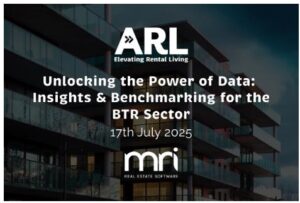How to reduce and manage operational carbon in the Build-to-Rent sector
The increasing global emphasis on sustainability has propelled Net Zero objectives into the spotlight across various industries. Within the real estate sector, there is a growing scrutiny of carbon emissions, and in the Build-to-Rent (BTR) market, attention has expanded beyond construction-related carbon issues to encompass operational carbon. This shift highlights the critical importance of effectively managing ongoing energy consumption in properties.
This article explores the significance of operational carbon, addresses the primary challenges encountered in the BTR sector, and outlines strategies that real estate companies can adopt to mitigate and control operational carbon with specific emphasis on the role of energy management software in this context.

What is operational carbon?
Operational carbon refers to the emissions produced during the day-to-day operations and ongoing activities of a building, facility or business. These emissions arise from the energy consumed for heating, cooling, lighting and other operational functions. While construction-related carbon is crucial to address, operational carbon accounts for a substantial portion of a building’s overall carbon footprint over its lifecycle.
In the Build-to-Rent sector, understanding and addressing operational carbon have become crucial components of sustainability efforts to meet ESG targets. This includes adopting energy-efficient technologies, optimising resource use and implementing sustainable practices to reduce the overall carbon footprint associated with the ongoing use of a property. As the global push for sustainability and net-zero targets increases, there is a growing focus on managing and minimising operational carbon emissions to achieve more environmentally friendly and sustainable built environments.
What is the difference between embodied and operational carbon?
Embodied carbon and operational carbon are two distinct concepts related to the environmental impact of buildings and structures.
Embodied carbon refers to the total greenhouse gas emissions associated with the production, manufacturing, transportation and construction of building materials and components – essentially, the carbon footprint incurred before a building becomes operational. This includes emissions from the manufacturing of materials like concrete and steel, as well as their transportation to the construction site.
Operational carbon, however, encompasses the ongoing emissions associated with a building’s day-to-day functions, such as heating, cooling, lighting and other routine activities. While embodied carbon is incurred during the construction phase, operational carbon is a continuous concern throughout the entire operational lifespan of a building. Emissions from electricity consumption, heating, ventilation and air conditioning (HVAC) systems, and other utilities contribute to operational carbon.
Typically, around 70% of a building’s carbon emissions are attributed to operational carbon, with the remaining 30% being associated with embodied carbon.
How do you calculate operational carbon?
The process of calculating operational carbon can vary in complexity, but a basic method involves the following steps:
Identify sources of energy consumption: List all energy-consuming systems and activities within the building, including heating, HVAC, lighting and appliances.
Gather energy consumption data: Collect energy usage data from utility bills, meters or building management systems.
Convert energy consumption to carbon emissions: Use emission factors or conversion coefficients to translate energy consumption into carbon dioxide equivalent (CO2e) emissions.
Calculate total operational carbon: Sum the calculated CO2e emissions from g source to obtain the building’s total operational carbon.
Consider secondary emissions: Include operational activities that may have indirect emissions, such as waste management or water consumption.
Periodic review and adjustment: Regularly review and update the calculations to account for changes in energy consumption patterns, efficiency improvements or the adoption of renewable energy sources.
Use specialised tools: Utilise specialised software or online calculators designed for operational carbon assessments to streamline the process and provide more accurate results.
Why is operational carbon a hot topic in the BTR sector?
Tenant attraction:
In an era where ecological and economic consciousness holds sway, tenants are inclined towards buildings that actively address operational carbon and energy costs. Properties equipped with measures to reduce operational carbon are more appealing than those lacking such sustainability initiatives.
Compliance with Net Zero targets:
Guidelines set forth by the UK Green Building Council (UKGBC) and the World Green Building Council (WorldGBC) emphasise the need for new constructions to adhere to sustainability-driven standards and existing structures to undergo retrofitting with advanced technologies for better energy consumption control. Prioritising energy-use reduction over other measures is crucial, especially in light of the fact that offsetting schemes take years to make a significant carbon impact and relying solely on procuring green energy is deemed unreliable due to its dependency on economic factors.
Financial opportunities:
Efficient and sustainable operations offer a financial upside by reducing the costs associated with managing BTR properties. Moreover, an increasing focus on environmental, social and governance (ESG) aspects is gaining significance among investors. While BtR sector investments are generally robust, projects with strong ESG credentials can leverage investor interest, potentially influencing investment availability and terms positively.
What are the key challenges?
- Diverse tenant behaviour: BTR buildings cater to a diverse tenant base with varying energy consumption patterns and preferences. Predicting and managing energy use becomes challenging, requiring customised solutions to accommodate the diverse needs of occupants.
- Legacy infrastructure: Older BTR buildings may have outdated and inefficient systems that contribute significantly to operational carbon. Upgrading or retrofitting these structures to meet modern sustainability standards often involves substantial costs and logistical challenges.
- Rising energy costs: Fluctuations in energy prices, economic conditions and market trends can influence the financial viability of sustainable initiatives. Real estate companies must navigate these external factors while striving to maintain cost-effective solutions for carbon reduction.
- Data accessibility: Limited access to accurate and real-time energy consumption data hinders effective decision-making and the implementation of targeted energy-saving measures.
How can real estate companies reduce and manage operational carbon?
- Energy-efficient building design: Implementing sustainable design practices during construction significantly reduces the need for energy consumption during the operational phase. This includes the use of renewable energy sources, energy-efficient appliances and advanced insulation.
- Behavioural change programmes: Engaging tenants in energy-saving practices through awareness programmes and incentives can positively impact operational carbon reduction.
- Technology integration: The adoption of smart building technologies, including IoT devices and sensors, enables real-time monitoring of energy usage. This data can inform decision-making for energy-efficient operations.
- Renewable energy solutions: Incorporating renewable energy sources, such as solar panels or wind turbines, can directly offset operational carbon emissions.
FAQ’s
Dandara Living doubles down on MRI Software’s Insights platform to power its ambitious growth plans
Dandara Living, a leading vertically integrated residential property developer, asset manager, and operator, is embarking on a significant growth phase, pivoting towards third-party management and expanding its portfolio. With over half a decade of e…

